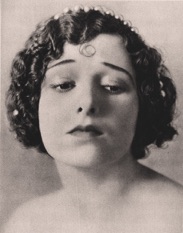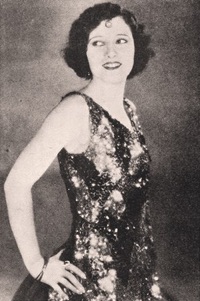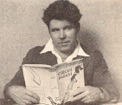The Gold Rush 1923 1924 1926 next previous
The Gold Rush Clippings 211/363
Jim Tully, Photoplay, New York, August 1925.
Author with a hobo‘s past. In other words, Jim Tully.
Tully‘s book, Circus Parade, is being produced
by James Cruze, and Tully is assisting in the writing of the dialog.
(...) Exhibitors Herald-World, Dec. 21, 1929
„Girls with broken ankles have a sad time“
Editorial content. „The Girl with the Broken Ankle
The story of Georgia Hale who was willing to work for nothing
Told by Jim Tully“
Two Georgia Hale Photos.
„She has only played in four pictures; in two of them
she was the leading woman. And now Georgia
Hale has been signed by Charles Chaplin. You will see
her in ,The Gold Rush.‘“
„Georgia was discouraged – she was leaving Hollywood –
when Fate stepped in and made her famous.“
This is the story of a girl who won a Chicago beauty
contest. She came to Hollywood with high hopes – alone. So our
tale opens with Georgia Hale – a very fine looking girl –
recently out of a Chicago high school – and out of a job. She
had unknowingly jointed that band of screen immortals
whom the casting directors had discarded.
That was two years ago. It is not a long period of time.
To start unknown and become Charlie Chaplin‘s
leading lady in that period is something worthy of note. Georgia
Hale is today acclaimed as one of the best actresses
on the screen. And of course that made it so much harder for
her. In no other business in the world is talent such
a handicap. She has acted in four pictures – as an extra in two
of them – as a leading lady in the other two. Her work
in the last picture, Charlie Chaplin‘s The Gold Rush, will make
her world famous. Georgia has just signed a two-year
contract with Charlie Chaplin. The New York writers with
stepladders on their foreheads and florid French
writers go clear dotty when they write about Chaplin. In one
thing is he supremely great – and I write as one who
has been for eighteen months on his payroll... when it comes
to motion pictures, he stands almost alone, with a touch
of genius. Now for the story.
Rupert Hughes was making True as Steel for Goldwyn
at the time she arrived in Hollywood. He made a valiant effort
to use Georgia, making a test of her which ran four
hundred feet. Georgia waited two weeks and looked through
many a doughnut in the waiting – for I have forgotten
to say that Georgia landed in Hollywood with thirty dollars
in money – the rest in faith. She got word after a weary
time that she ,was unsuited to the part.‘
She made rounds of the studios – day after day and
week after week. A landlady had faith – as landladies
do sometimes – else where would poets sleep? Georgia owed
money in large measure, for a high school girl, and after
a while she was given a part in the chorus of Vanity‘s Price. She became so excited over this that she broke her ankle.
Now girls with broken ankles have a sad time of it –
in Hollywood. The landlady still had faith. Georgia
wrote cheering letters to her parents in Chicago and somehow
suffered it through. Those weeks with the broken ankle
meant more to Georgia than she realized at the time. She had
a good brain, and she used it to think with during these
troublous days, little realizing she was to be
a picture star.
A short time after she was able to walk, she went to the
depot and asked the fare to Chicago. She was walking
toward the turning point in her life – but how is one to know?
She had met, casually, a young Austrian director,
who was also looking for the turning point in his life. He was not
a director then, but a sometime assistant director and
a cameraman so gifted that he was out of a job. His name was
Josef von Sternberg. He had seen Georgia doing her
stuff in Vanity‘s Price, and he felt that she had talent. When she
told him at the depot that she was tired and was trying
to get home, he felt certain she had much more than talent. He
was looking about at the time for players who wanted
to work for glory, as he had a picture that was to cost the great
sum of forty-five hundred dollars – the labor, the lease
of the studio and everything. When it was considered that
Milton Sills will hardly discuss Schopenhauer with
a producer for that amount, Sternberg‘s problem will be made
more vivid.
,It was wonderful,‘ I said, ,that Jo saw your talent and
was willing to give you a chance as his leading lady.‘
,Well,‘ replied Georgia, ,I was willing to work for nothing.‘
There, at the railroad station, the drifter from Austria
and the drifter from Chicago – unknowingly leaped on a horse
that was to carry them both to fame and fortune.
Georgia became the leading lady in Sternberg‘s Salvation
Hunters.
I saw this picture four times – once with Charlie Chaplin.
Georgia‘s performance in it is one of the finest I have
ever seen. I watched the real Chaplin that night as he watched
this girl at work. I said to him, ,She is greater than –
so and so‘ naming a well-known player. ,Far – far – greater,‘
was Chaplin‘s rejoinder.
It is presumed that producers saw her marvelous work.
I am certain of this – for none of them engaged her.
Fairbanks, through a combination of circumstances, put her
under contract – and the wily Chaplin, casting about
for a new leading lady, ,lifted‘ her contract. She played the
leading rôle in Chaplin‘s Gold Rush. No Chaplin –
like most all men of great talent – has no patience with people
who have the urge without the gift. A bad player will
throw him into a mood that may last for days. Georgia‘s work
made him happy. I am writing this before the picture
is shown. My prediction – a very great actress is walking down
the road of time. She has poise and controlled fire,
dignity without affectation and demeanor that must be born with
the individual. I think she is one of the greatest actresses
on the screen, and Chaplin thinks so too. He has signed a contract
with her, and it is one of the very smartest things this
terrific little vagabond has ever done.
Georgia Hale was about to become Rudolph Valentino‘s
leading woman. Joseph Schenck said to her, ,You can
wear clothes – you‘ve got everything.‘ Chaplin saw all this first
– Georgia became his leading lady.
Georgia has long since sent for her parents. They live
in Hollywood with her.
I have forgotten to mention – her ankle is completely
healed.
So is her pocketbook.“
This is the contribution written by Chaplin’s former press
agent Jim Tully for Photoplay. The text about
Georgia Hale in the program of Grauman’s Egypt Theatre
in Los Angeles seems to be written also by Jim Tully.
You‘ll find the broken ankle in both texts.
The Gold Rush opens June 26, 1925
at Grauman‘s Egyptian, 6712 Hollywood Bld., Los Angeles.
The Gold Rush opens August 15, 1925
at Strand Theatre, B‘way at 47th St., New York.
Redaktioneller Inhalt. „Das Mädchen mit dem
gebrochenen Knöchel
Die Geschichte von Georgia Hale, die bereit
war für nichts zu arbeiten
Erzählt von Jim Tully
Das ist die Geschichte eines Mädchens, das in Chicago
eine Schönheitskonkurrenz gewonnen hat. Sie kam nach
Hollywood mit grossen Hoffnungen – allein. So beginnt unsere Geschichte von Georgia Hale, einem sehr schön
aussehenden Mädchen, geradewegs aus einer High School
in Chicago und ohne einen Job. Sie hatte sich
unwissentlich dem Verband der Unsterblichen im Film
zugesellt, welche die Casting Directors aussortiert
hatten.
Das war vor zwei Jahren. Es ist keine lange Zeitperiode.
Unbekannt anzufangen und in dieser Periode Charlie
Chaplins Leading Lady zu werden ist eine Notiz wert. Georgia
Hale wird heute als eine der besten Schauspielerinnen
der Leinwand gefeiert. Und natürlich hat es das für sie nur noch
härter gemacht. In keinem anderen Business der Welt
ist Talent ein solches Handicap. Sie hat in vier Filmen gespielt
– in zwei davon als ein Statist, als Hausdarstellerin
in den zwei anderen. Ihre Arbeit im letzten Film, Charlie
Chaplins The Gold Rush, wird sie weltberühmt
machen. Georgia hat gerade einen Zwei-Jahres-Vertrag
mit Charlie Chaplin unterzeichnet. Die New Yorker
Schriftsteller mit Sprossenleitern in ihren Dickschädeln und die blühenden französischen Literaten sind glatt aus dem
Häuschen, wenn sie über Charlie schreiben. In einer Sache ist
er absolut grossartig – und ich schreibe das als einer,
der achtzehn Monate auf seiner Lohnliste gestanden hat –
wenn es um Filme geht, steht er nahezu allein da, mit
einem Touch von Genie. Jetzt zur Story.
Rupert Hughes machte für Goldwyn True as Steel
zu der Zeit, als sie nach Hollywood kam. Er gab sich ernsthaft
Mühe Georgia zu besetzen und machte mit ihr eine
Testaufnahme, über hundert Filmmeter. Georgia wartete
zwei Wochen und blickte während des Wartens
durch so manchen Pfannkuchen hindurch, ich vergass nämlich
zu sagen, dass Georgia in Hollywood gelandet war
mit dreissig Dollar Bargeld– der Rest ist Glauben. Nach einer zermürbenden Zeit wurde ihr mitgeteilt, sie sei ,für die
Rolle ungeeignet‘.
Sie klapperte die Studios ab, Tag für Tag, Woche für
Woche. Eine Pensionswirtin glaubte an sie, wie Pensionswirtinnen
das manchmal tun – wo würden Poeten sonst schlafen?
Georgia schuldete jede Menge Geld für ein High School Girl
und nach einer Weile erhielt sie eine Rolle im Chorus
von Vanity´s Price. Sie war darüber so aufgeregt, dass sie sich
ihren Knöchel brach.
Das ist für Mädchen mit gebrochenen Knöcheln jetzt
eine traurige Zeit – in Hollywood. Die Pensionswirtin
glaubte noch immer an sie. Georgia schrieb aufmunternde Briefe
an ihre Eltern in Chicago und irgendwie stand sie es
durch. Jene Wochen mit dem gebrochenen Knöchel bedeuteten
für Georgia mehr, als ihr zu der Zeit bewusst war. Sie hat
einen klugen Verstand, und in den beschwerlichen Tagen hat sie
ihn zum Nachdenken verwendet und ihr ist kaum in den Sinn gekommen, sie würde ein Filmstar werden.
Kurze Zeit, nachdem sie wieder gehen konnte, ging
sie zum Bahnhof und fragte nach dem Fahrpreis nach Chicago.
Sie ging auf den Wendepunkt ihres Lebens zu – aber
wie soll man das wissen?
Zufällig traf sie einen jungen österreichischen Regisseur,
der ebenfalls auf der Suche nach dem Wendepunkt
seines Lebens war. Er war da noch kein Regisseur, gelegentlich
aber Regieassistent und ein so begabter Kameramann,
dass er ohne Job war. Sein Name war Josef von Sternberg.
Er sah Georgia in Vanity´s Price ihr Zeug machen
und er spürte, sie hatte Talent. Als sie ihm am Bahnhof erzählte,
sie sei müde und versuche heimzukommen, da war
er überzeugt, sie hatte viel mehr als Talent. Er sah sich zu der
Zeit gerade nach Schauspielern um, die um des Ruhmes
willen arbeiten wollten, denn er war an einem Film, der die grosse Summe von 4500 Dollar kosten sollte – Labor, Studiomiete
und alles. Wenn man bedenkt, dass Milton Sills für diese Summe
mit einem Produzenten nicht einmal über Schopenhauer
diskutieren wird, macht das Sternbergs Problem anschaulicher.
,Es war wunderbar‘, sagte ich, ,dass Jo dein Talent
erkannte und bereit war dir eine Chance als seine Hauptdarstellerin
zu geben.‘
,Nun‘, antwortete Georgia, ,ich war bereit für nichts
zu arbeiten.‘
Dort, am Bahnhof, der aus Österreich Hergetriebene
und die aus Chicago Hergetriebene – ahnungslos bestiegen sie
ein Pferd, das sie zu Ruhm und Vermögen führte.
Georgia wurde die Hauptdarstellerin in Sternbergs Salvation
Hunters.
Ich sah den Film viermal – einmal mit Charlie Chaplin.
Georgias Darstellung darin ist eine der schönsten,
die ich je gesehen habe. Ich sah in jener Nacht den realen
Chaplin, wie er diesem Mädchen bei der Arbeit zusah.
Ich sagte zu ihm ,Sie ist besser als so und so –‘ und nannte
eine sehr bekannte Schauspielerin. ,Viel – viel besser‘,
erwiderte Chaplin.
Es ist anzunehmen, dass Produzenten ihre wunderbare
Arbeit gesehen haben. Ich bin dessen sicher – denn
keiner von ihnen hat sie engagiert. Douglas Fairbanks nahm
sie durch eine Fügung von Umständen unter Vertrag
– und der raffinierte Chaplin, der seine Hauptdarstellerin neu
besetzte, ,liftete‘ ihren Vertrag. Sie spielte die Hauptrolle
in The Gold Rush. Nun hat Chaplin – wie die meisten Männer
grossen Talents – keine Geduld mit Leuten, die Ehrgeiz,
aber keine Begabung haben. Ein schlechter Darsteller stürzt
ihn in schlechte Laune, die tagelang anhalten kann.
Georgias Arbeit machte ihn glücklich. Ich schreibe das, bevor
der Film gezeigt wird. Meine Vorhersage – eine sehr
grosse Schauspielerin geht die Strasse der Zeit herunter.
Sie hat Haltung, kontrolliertes Feuer, Würde, keine
Affektiertheit und ein Benehmen, wie sie einem Individuum
angeboren sein müssen. Ich denke, sie ist eine der
grössten Schauspielerinnen der Leinwand, und Chaplin denkt
genauso. Er hat einen Vertrag mit ihr abgeschlossen,
und es ist eines der smartesten Dinge, die dieser fantastische
kleine Vagabund je getan hat.
Georgia Hale war dabei Rudolph Valentinos
Hauptdarstellerin zu werden. Joseph Schenck sagte zu ihr:
,Sie können Kleider tragen – sie haben alles.‘ Chaplin
sah all das zuerst – Georgia wurde seine Hauptdarstellerin.
Georgia hat ihre Eltern lange schon nachgeholt.
Sie leben mit ihr in Hollywood.
Ich habe vergessen zu erwähnen – ihr Knöchel ist komplett ausgeheilt.
Ebenso ihre Brieftasche.“
Das ist der von Chaplins ehemaligen Pressechef
Jim Tully für Photoplay verfasste Beitrag. Schon der Text
zu Georgia Hale im The Gold Rush Programmheft
von Grauman‘s Egypt Theatre in Los Angeles dürfte von
Jim Tully gewesen sein. Hier wie dort dient ein
gebrochener Knöchel als Aufhänger.
The Gold Rush 1923 1924 1926 next previous








